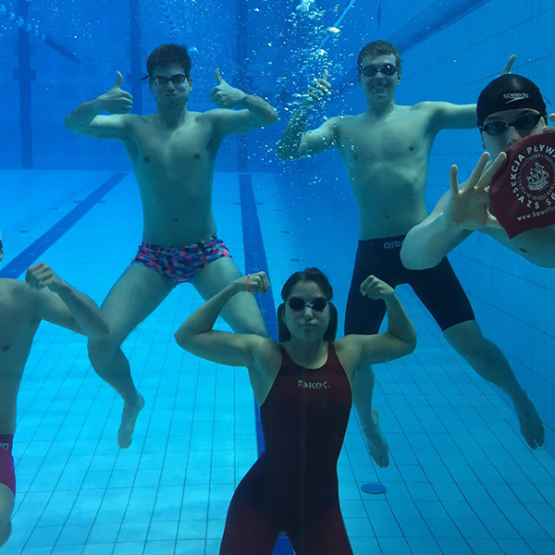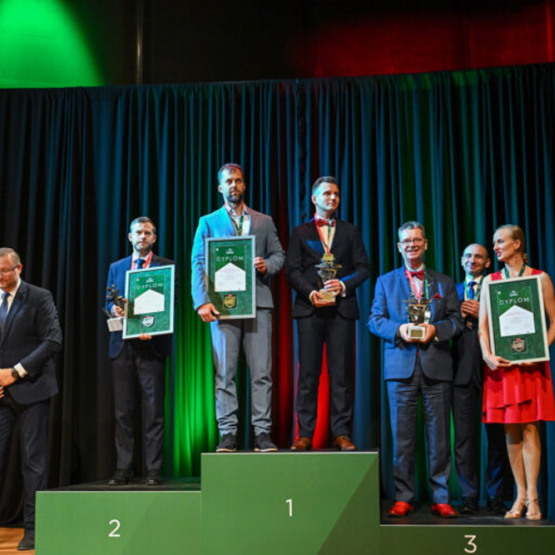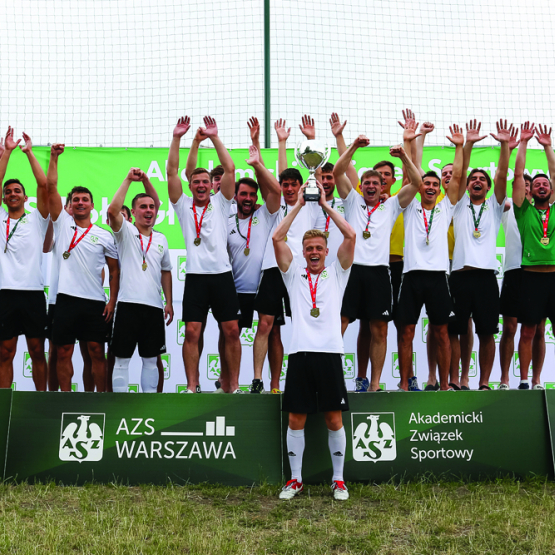
At the beginning of February 2024, he again stood on the podium of the World Championships in the DN class – the world’s largest iceboat class. Cezary Sternicki, a student of the SGH Warsaw School of Economics and a member of the AZS SGH sailing club, talks about the beginnings of his sports career, training off-season and plans for the future.
Magdalena Bryk: I probably won’t surprise you with this question, but it’s hardly possible not to begin with it. Where did the idea to practise this sport come from? I think you will agree with me that iceboating is not the most popular sport.
Cezary Sternicki: Yes, I agree (laughs). The idea was not mine, but my sailing coach’s. I trained sailing at the Baza Mrągowo club (one of the oldest sailing clubs in Poland) and one winter the coach asked us if we wanted to try our hand at iceboating. Back then, the winters were cold enough so you could train in Poland, also in my hometown of Mrągowo. Lake Czos was frozen for several months, the equipment was in the club, the coach was there too, so there could not have been a better opportunity to try. Some people liked it and stayed for longer – just like me. And so I’ve been training iceboating for 10 years now.
Did you immediately quit sailing for iceboating or did you combine these two sports for some time?
Initially, I combined them. Water sailing is more prestigious because it is an Olympic sport. Iceboating is rather off the beaten track, so I tried to reconcile these two for a few years. Over time, however, sailing required more and more commitment, both in terms of time and money, and more or less at the beginning of high school, I focused only on iceboating. You can’t make a living from sailing without being at the Olympic level, so it was also getting harder and harder and this decision was just reasonable.
Once you have touched on the topic of money, is it possible to make a living from iceboat racing?
Not at all (laughs). But it seems to me that it is simply a more interesting sport. Besides, the specificity is different. The season is definitely shorter than in the case of sailing. Some, of course, get prepared all the year round, but the vast majority of iceboaters start preparing a few months before the start, and before that they have a break of several months. In the case of sailing, this is practically impossible – you have to be involved in it all the year round. In other words, even the top iceboaters are able to reconcile sport with paid work, which is almost impossible in the case of water sailors. There is also a small group among us who make a living from professional sea sailing, and iceboating in winter is simply an additional sport.
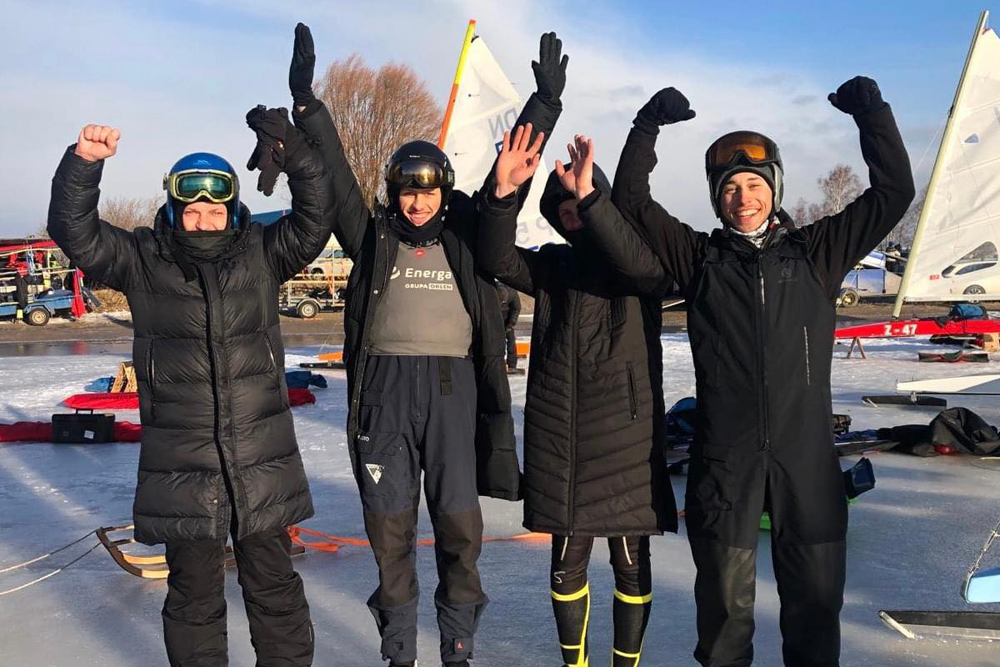
How many months a year do you train?
Roughly speaking, from December to March. But you should remember that iceboating is not only about what you do on the ice, but also about your work on the equipment, and you can definitely do it all the year round. The preparation of the iceboat translates into the speed to be achieved and, consequently, the result in the competition. This is a fast sport. We are talking about speeds of up to 120 km/h. If your iceboat is able to accelerate to a maximum speed of 115 km/h, and the competitor next to you, thanks to better preparation, makes it 120 km/h, then on a 20-kilometer route you have no chance against such a rival.
Do you have your own equipment now or do you continue to train on the club equipment?
Currently, I have my own equipment, only a few parts are club-owned. I could continue training on the club’s equipment, but I would not have a chance for such results. Iceboating is a strictly equipment based sport and even a 10-time world champion on a poor iceboat will not be able to race for medals.
We’ve already agreed that you will not make money on iceboating, so how much do you have to spend? It is an expensive sport, isn’t it?
Yes, it is an expensive sport with a high entry barrier. Maintaining the equipment is no longer that expensive, but buying all the necessary components is a considerable expense. If you would like to buy everything new from the manufacturer, it is an expense of about 80 thousand zlotys and then you will not have many sets of runners. And you need several sets of such runners, i.e. the elements that come into direct contact with ice. The best iceboaters have up to 10-15 of them, and each costs from 4 to 10 thousand zlotys! In addition, you have to keep this iceboat somewhere out of season. If someone doesn’t have a garage, it causes more costs, fortunately I have one at home, so at least this lets save (laughs).
So you should have an additional 100 thousand for the runners alone?
Well, maybe not that much, at least not at the beginning. Such basic equipment for 80 thousand zlotys usually includes two or three sets of runners. That’s why most of us start by buying used components. Used equipment can be bought for only 30-40 thousand zlotys and such an iceboat will be reasonably good. Usually, the equipment is accumulated over years – one year you buy a hull for 10 thousand, the next – a mast for another 10 thousand and so on for five or six years until the whole thing is completed. Therefore, we, young iceboaters, have very little chance to compete against the older guys. Apart from experience, which is also, of course, very important, they have the equipment that we simply cannot compare ours to.
Thus, how much success in this sport comes from the equipment, and how much from the athletes themselves and their experience?
This is a difficult question. As you also have to understand that equipment alone does not guarantee success. You have to be able to prepare and “pamper” it. A lot of things in this equipment are to be changed and you need to know how to use it, e.g. how to sharpen the runners, which sail to choose, etc. But to answer the question – the equipment itself is about 20-30% of success. But if you add in the ability to trim it and react to changes in the conditions during competitions, we already come up to about 70-80% of success.
Oh, that’s a lot! Do you have your own serviceman or are you one yourself?
I am a serviceman myself. Iceboats are a bit of “secret knowledge”. Few people know that we have to acquire this knowledge ourselves either by trial and error, or by asking more experienced people – coaches or other competitors. And surely, if my equipment was set up by the senior world champion, he would be able to squeeze more out of it than what I am currently able to do on my own.
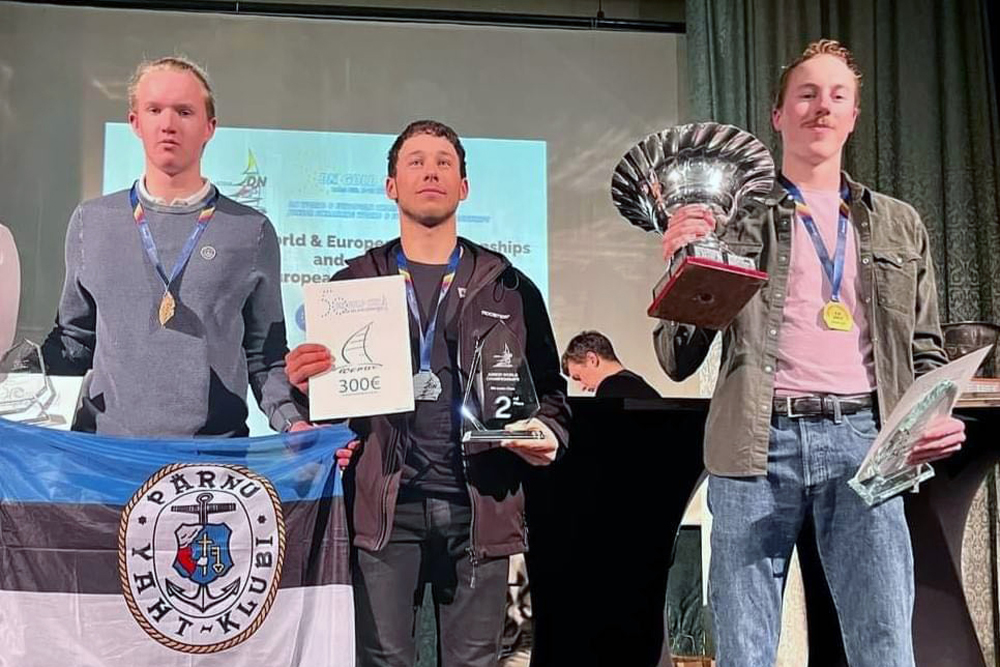
And you can really approach the senior world champion and ask how to trim the equipment?
Of course, some people are more willing to share their knowledge than others, but yes – we ask older guys about many things. Some of them answer only perfunctorily, but you can really learn a lot from some others. We, the younger ones, also know who to approach (laughs). Sometimes we also buy something from the older iceboaters (juniors often buy equipment sold by champions), and then we get some instructions and advice at the same time. I think that if I hadn’t asked older iceboaters about some things over the years, I wouldn’t be where I am or at the level I am at now.
Speaking of which, you are the current world junior vice-champion. Is this your greatest achievement so far?
Yes, definitely.
Did you expect this success?
Let me put it this way: I didn’t want not to put too much pressure on myself, but I had it somewhere in the back of my mind. In 2023, however, I was third, in 2022 – fourth, and in 2021, I was also third. After all, I could have expected success, but I tried not to think about it too much, so that I wouldn’t blame myself and break down if I didn’t succeed. That’s why I wasn’t surprised by this medal. The gold was close, I lost it by just one race, but I’m happy with the silver. I would also be happy with the bronze, probably not so much with the fourth place (laughs).
And you don’t regret that it wasn’t the gold after all?
I regret it a bit, because there was a great chance to do it in this regatta. There is a junior from Sweden, Oskar Svensson – a great talent, a sensation on a global scale, who two or three years ago had a bronze medal in the senior world championships. In 2024, he exceptionally did not take part in the regatta, because he is currently doing military service and did not get a leave to come to this competition, so if there was a chance for the gold, it was only now (laughs). When he appears in the regatta, he is practically unbeaten – out of seven races in junior competitions, he usually wins at least six.
This year we did not see you at the start of the World Championships or the European Championships, why?
To cut it short, this year, unfortunately, when the World Championships and the European Junior Championships were planned, there was no ice in this part of Europe, so the decision was made to postpone the competition from February to December 2025. So it’s not that I didn’t take part, it’s just that this year’s junior championships haven’t taken place yet. The competition you are asking about is the senior regatta, this year was held in the United States. Unfortunately, it is too big a logistical challenge for me at the moment to compete in them (every other year the World Championships are alternately in America and Europe). The Senior European Championships have also finished recently, but when I already knew that the Junior World Championships would take place in December, I decided that competing in the European Senior Championships would not give me much. The chances for a medal are negligible, and the experience from February in December does not pay off that much.
What are your plans for the coming years? Do you want to continue competing in this sport or did you choose SGH to steer your career in a different direction?
If there are real winters, I will definitely want to compete. Certainly until the end of the junior category, i.e. until the end of 2025. I think that later I will have a break (how long, it remains to be seen), because to match the senior leaders, I would have to devote a lot of time and resources to it.
And you would have to buy a new iceboat?
Probably, I would. And I would have to buy new equipment, refine it and then I could get back to racing.
And when are iceboaters in their prime? How old are the best competitors?
It’s a bit of a “sport for greybeards” (laughs). Both sailing and iceboating are largely mental sports. Here, experience combined with equipment really pays off. In Poland, one of the most famous examples is Karol Jabłoński, who won his first world championship title at the age of about 30. Now he is 60 and still competing, and he is among the world’s best. In this sport, age definitely does not interfere, and can even help.
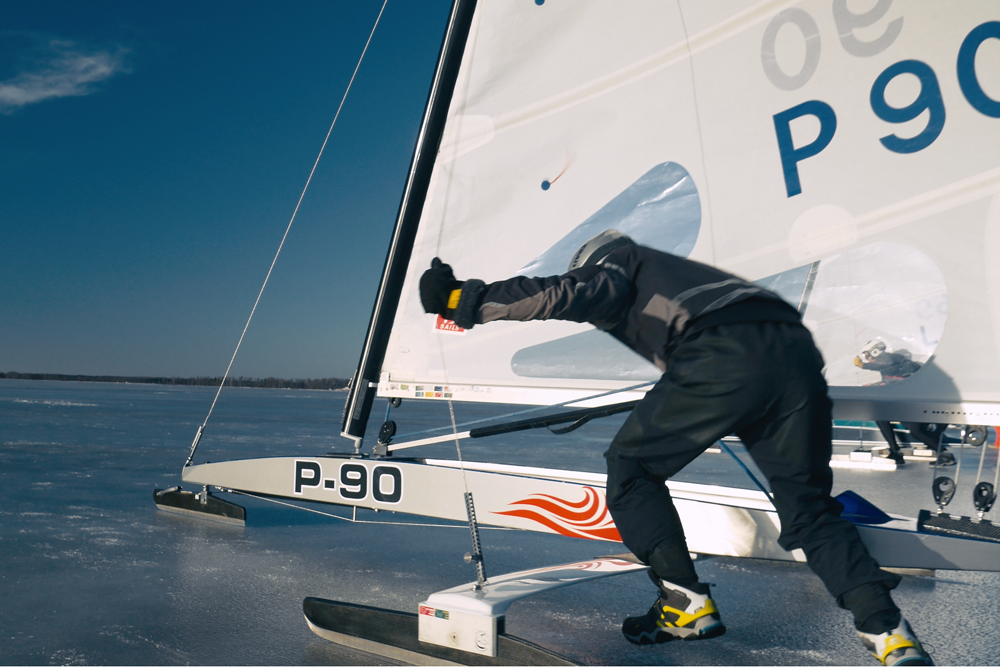
Can I say then that you will manage to come back, even if your break lasts several years? And what do you see as the future of this sport in view of warmer winters and global warming?
In 2024, there were three national competitions held, and this is really much with regard to our current winters. For comparison, I will say that two and three years ago there were no competitions in our country, and the same this year. And I still remember that in 2017 there were six or seven competitions; in the past, six to eight competitions could be organised in Poland as a rule. And now you have to hold competitions as soon as there are any conditions. That is why we have to look for ice in Estonia or Finland.
And I assume that countries such as Finland, Estonia or Sweden are a power in this sport.
In fact, we are a power, although it is becoming more and more difficult to find ice and good conditions for training. Last year, there were as many as six Poles in the top ten of the World Championships. Estonia was second and Sweden came third. Poland is currently at a very high level. To become the Polish champion now, you would have to beat the current world champion! Currently, we have five or six active iceboaters who once won medals at the European and World Championships.
Do you think that with the current climate change, this sport has a chance to survive?
Unfortunately not, I’m afraid. The conditions are getting tougher, the winters are getting shorter, and there are very few new racers. In Poland, in five or six years, there will be no more juniors, because there will not even be a way to show them this sport in the Polish climate. When I competed in the first Ice Optimist competition (a competition for the youngest iceboaters), there were about 50 iceboaters from almost 10 countries on the start line. Currently, although only a few years have passed, there are about 15 iceboats from two countries: Estonia and Lithuania on the start line. So you can see how quickly it is progressing; in a few years, the Ice Optimist class will actually cease to exist. And if there are no youngest now, then in a dozen years there will be no juniors, etc.
Since it is becoming more and more difficult to have a real winter in Poland, how can you prepare for this sport apart from iceboating alone? You mentioned sailing as a good introduction. Does anything else prove useful, perhaps a gym?
Yes, the gym, definitely, especially strength and speed elements and sprints. Strength leg training is particularly useful, because during competitions the iceboats stand on one line and we accelerate them at a signal. We have to sprint hard for the first 5-10 seconds, so definitely strong legs are really necessary then, especially when there is not much wind. In addition, the position in the iceboat itself is unpleasant, because you lie on your back, but your head has to be raised all the time to look towards your feet and see what is happening on the route. The abdominal and neck muscles also need to be well trained. If someone has weak muscles, their head drops, and this is simply dangerous. In addition, in the summer, more and more iceboaters train on foil, i.e. on a boat that rises above the surface of the water at a certain speed and, like the iceboat, moves to a greater extent due to the apparent wind, where the own wind component is much greater than in classic sailing.
Is it a safe sport? At the speeds you reach, broken ice may give rise to a serious accident. Are there many accidents in iceboating?
With safety rules and common sense, it is a safe sport. Of course, the more difficult the conditions, the more dangerous it is, but with gentle winds and clear ice, it is a really safe sport. Of course, the faster, the easier it is to have accidents. There are collisions, including those where the equipment is damaged, but there has not yet been a case of ice breaking. Before the competition, the reservoir is always thoroughly checked by experienced people (at least the part where the competition is held) to make sure that it is a safe place to start. I had two collisions in my career and in both cases the equipment was damaged, but we, the racers, were fine. Yes, there are 50 iceboats on the start line, but during the race they are apart, so this also reduces the risk of a collision.
You said that the ice is checked, but if such a iceboat fell into the water, would it stay on it?
It should, but I haven’t tested it yet, thankfully.
And let’s hope it stays that way! And finally – what shall I wish you?
Thick ice and cold winters.
And that’s exactly what I wish you, thank you very much for your time and the interview.
MAGDALENA BRYK, member of the AZS SGH Management Board
PHOTO. Herkules Pierewoj

